London's emergency preparedness guide

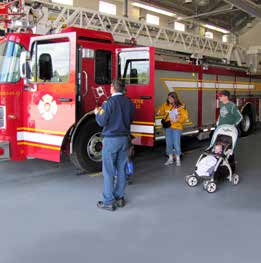
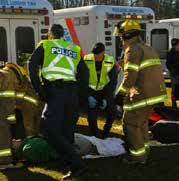
preparedness guide
A step by step planner to help your family prepare
for emergencies and disasters
Preparation you can't live without.
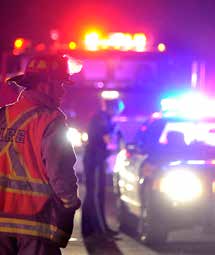
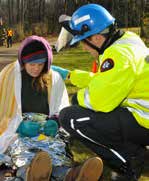
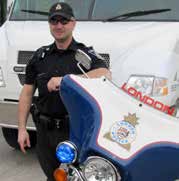
Using 911 and Emergency Contact Numbers
call 911 When you need Police, fire or
Paramedic services to resPond immediately
When should you call 911?
Call 911 if there is:
• a medical emergency
a medical emergency
involves a serious or
• a crime in progress
life-threatening injury
Do not Call 911 to:
• locate relatives or to inquire about their condition
• ask about current road or weather conditions
• find out when electricity and gas services will return
in the event of an emergency, information and
instructions from emergency response officials will be
available on the radio, television and the internet.
you can also get information by using non-emergency
telephone numbers.
When there is no immediate danger to health or
property use a non-emergency number.
MY PERSONAL NON-EMERGENCY CONTACTS
519-661-2500 ext. 4565
Middlesex – London Health
emergency PreParedness guide - are you ready?
Table of Contents Your Emergency Preparedness Planner
Emergencies: Be Prepared
Non-Emergency Contact Numbers
Personal Emergency Contact Numbers
Emergencies: Be Prepared
Step 1. Know the Risks
Step 2. Make a Plan
Create a Home Escape Plan
Identify a Meeting Place Away From Your Home
Record Your Emergency Contact Information
Choose an Out-Of-Area Contact Person
Copy and Protect Important Documents
Take an Inventory Of Household Possessions
Prepare an Evacuation Plan
Make a Plan For Your Pets
Step 3. Prepare a Kit
72 Hour Basic Emergency Kit
Vehicle Emergency Kit
Pet Emergency Kit
Step 4. Know What to Do During an Emergency
Water Treatment in Emergencies
How to Shelter-in-Place during a Hazardous Materials Incident
If You Need to Evacuate
Preparing for Severe Thunderstorms and High Winds
Winter Storms, Ice Storms, and Blizzards
Tornadoes and Windstorms
Extended Power Outages
After an Emergency
Insurance and Emergencies
Children and Emergencies
Coping with the Aftermath
Where to find More Information
EMERGENCY MANAGEMENT LONDON
EMERGENCY PREPAREDNESS GUIDE - ARE YOU READY?
Non-Emergency Contact Numbers
519-661-2500 ext. 4565
London Fire Services
London Police Service
519-661-5670 519-661-6472 TTY
community resources
Ontario Provincial Police
OPP 24 hour toll free telephone number
Canadian Red Cross.
London and Middlesex
Use this number to speak
with a police officer about a
non-emergency situation
London & Middlesex Mental Health Crisis
Community Information,
Middlesex - London
Distress Line Services,
Or visit their web site
Ontario Poison Centre
Telehealth Ontario
1-866-797-0007 TTY
Road Conditions and
Construction Info
Rescue Coordination Centre (AIR and MARINE
The Salvation Army Ontario Great Lakes
Divisional Headquarters
Environment Spill
St. John Ambulance
Please use the 911 serviCe
CorreCtly. if the system is flooded
Southwestern Branch
with non-emergency calls, then true emergency calls take longer to get through. this puts the health and safety of others at risk.
emergency PreParedness guide - are you ready?
PERSONAL EMERGENCY CONTACT NUMBERS
FAMILY CONTACT NUMBERS
OUT-OF-AREA CONTACT
FAMILY MEDICAL INFORMATION
Family Physician:
SChOOL(S)/TEAChER/ChILD CARE PROvIDER
EMERGENCY MEETING PLACE
In case you cannot return home, meet at:
WRITING DOWN YOUR CONTACT NUMBERS ALLOWS YOU TO QUICKLY
FIND CRUCIAL INFORMATION SHOULD AN EMERGENCY HAPPEN.
emergency PreParedness guide - are you ready?
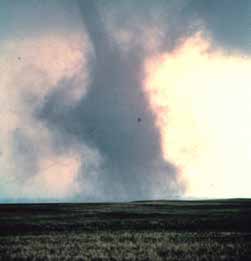
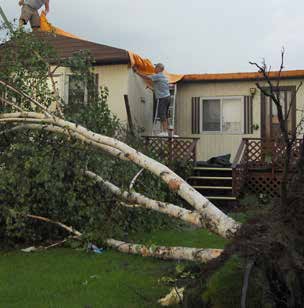
Emergencies: Be Prepared
Disasters and emergencies are unpredictable. They
can strike anytime and anywhere. Often they occur with
very little warning. Although the likelihood that one will
occur in our area may seem like a remote possibility, our
region of Ontario is susceptible to severe storms, flooding,
winter blizzards, and tornadoes.
Hazardous materials incidents, major transportation
accidents, power disruptions and disease outbreaks can
also have an impact on our area. Every year communities
such as ours experience events that pose a significant risk
to the lives, health and property of the people in them.
Emergencies have the potential to affect large numbers of
people and produce substantial damage to property. They
can be caused by accidents, forces of nature, technology
failures, disease outbreaks, or even be the result of
intentional acts.
If an emergency were to occur in our region, it
could pose a significant risk to the people, property,
environment and economic well-being of our
EMERGENCY PREPAREDNESS GUIDE - ARE YOU READY?
Emergencies: Be Prepared
In an emergency, the City of London and emergency
services will be working to ensure the safety of residents
and to reduce the damage caused by the event.
They will also work closely with hospitals, public health, local
utilities, businesses, provincial ministries and other community
partners to mount a co-ordinated response to the situation.
This work will continue through the recovery phase to restore
conditions to normal as quickly as possible.
When a disaster occurs, emergency workers focus their initial
efforts on helping people who need immediate, urgent assistance.
As a result, if your neighbourhood is not in immediate danger, it may
take time for workers to clear roads and restore utilities to your area.
Therefore, it is important to be prepared to cope without regular
services and assistance for a period of time. In an emergency you
may need to take shelter in your home or workplace. You could be left
without electricity, heat or water for hours or even a few days. In some
circumstances you might even need to leave your home and evacuate to
All residents should plan for these situations and be prepared to
be as self-sufficient as possible for at least 72 hours.
ThIS GUIDE IS DESIGNED TO hELP YOU CONSTRUCT AN EMERGENCY PREPAREDNESS PLAN FOR YOU AND YOUR FAMILY. DEvELOP, DISCUSS AND PRACTICE YOUR PLAN TOGEThER.
emergency PreParedness guide - are you ready?
There are three steps you can take to help you
and your family prepare for an emergency:
Step 1 - Know the Risks
In City of London, we are fortunate to live in a relatively safe region
of Canada. However, that does not mean that we are immune to
the possibility of a large-scale emergency.
A hazard identification and risk assessment study conducted by the City of London
has identified the following potential hazards in our region:
Severe weather and other
Snowstorms, ice storms, extreme temperatures,
meteorological events
windstorms, tornadoes, floods, fires
Hazardous materials incidents, explosions, transportation
accidents, water contamination, train derailments
Technological failures
Extended power failures, network interruptions, phone
Disease outbreaks
Widespread health emergencies, human or animal borne
diseases, pandemic influenza
Arson, crime, civil unrest
EMERGENCY PREPAREDNESS GUIDE - ARE YOU READY?
Emergencies: Be Prepared
Step 2 - Make a Plan
Emergencies can strike with very little warning, leaving you
with no time to make plans about where to go and what to do.
CHALLENGES YOU MIGHT FACE IN AN EMERGENCY:
You might not have the opportunity to gather resources
Family members may be in different locations when the
Communication networks can break down
It is possible that electricity, water or gas service to your
home will be disrupted
Roads could be blocked or closed
Regular sources of food, water and gasoline might not
IT'S UP To
RESIDENTS hAvE A KEY ROLE TO PLAY IN RESPONDING TO
EMERGENCIES. MAKE PLANS TO BE ABLE TO TAKE CARE OF YOURSELF AND ThE MEMBERS OF YOUR hOUSEhOLD FOR UP TO 72 hOURS.
Being prepared ahead of time will help you and your
family cope with an emergency more effectively and
enable you to make a faster recovery.
Emergencies can be particularly stressful for children,
seniors and individuals with disabilities or special needs.
They may feel especially vulnerable if they rely on
caregivers for assistance, but are separated from them
when the incident occurs. If your household includes a
person who requires extra help or has special needs, be
sure to include provisions for them in your plan.
emergency PreParedness guide - are you ready?
MAKE YoUR PLAN BEFoRE
AN EMERgENCY oCCURS
Create a home escape plan
Record your emergency contact information
Identify a meeting place away from your home
Choose an out-of-area contact person
Copy and protect important documents
Take an inventory of household possessions
Prepare an evacuation plan
Make a plan for your pets
CREATING A HOME ESCAPE PLAN
Make a plan to be able to leave your home quickly and safely in the event
of a sudden emergency.
Draw a floor plan of your home. Identify two ways that you can exit from each
room. Draw arrows on your diagram to show where these emergency exits are
located. Use a different colour ink to make the arrows stand out.
Consider buying a collapsible emergency ladder if you might need to exit from
an upper floor window or balcony. If you live in a high-rise building do not use
elevators in an emergency. Use the stairs instead.
Decide on a safe meeting place outside your home where
everyone will go if you need to get out in an emergency
(e.g. a fire). Ensure that everyone in your family knows where
the meeting place is and practice your home escape plan
EMERGENCY PREPAREDNESS GUIDE - ARE YOU READY?
Emergencies: Be Prepared
Safe meeting place near home:
USE ThIS AREA TO SKETCh YOUR hOME ESCAPE PLAN. IDENTIFY TwO wAYS TO ExIT FROM EACh ROOM AND MARK EACh wITh AN ARROw.
emergency PreParedness guide - are you ready?
RECoRD YoUR EMERgENCY
CoNTACT INFoRMATIoN
Members of your family may not be together at home when an
emergency occurs. Children may be at school, in daycare or
visiting friends. Adults may be at work or elsewhere. Make
plans to be able to contact each other in order to reunite.
gather a list of your emergency contact phone numbers.
Every family member should carry a copy of these numbers
with them at all times. Adults can keep a copy in their wallet or
store numbers in a mobile phone. Children can write them in
a school agenda, or keep a copy in a backpack. For younger
children give a copy to the child's teacher or daycare provider.
IDENTIFY A MEETING PLACE AWAY FROM YOUR HOME
Select a meeting place located well outside of your neighbourhood where everyone will go if you cannot return to your home in an emergency.
Location:
Contact phone #:
Make plans ahead of time about who will pick up children who are at school or daycare.
EMERGENCY PREPAREDNESS GUIDE - ARE YOU READY?
Emergencies: Be Prepared
CHooSE AN oUT-oF-AREA
Decide on an out-of-area emergency contact person. This person
should live far enough away that they will not likely be affected if a
disaster occurs in your area. Contact this relative or friend if you are
separated from your family in an emergency. They can co-ordinate
information about where family members are and help you to reunite
with them. You can also use this contact to provide information to
other relatives and friends to let them know that you are safe.
EMERGENCY CONTACT INFORMATION
Family Member:work phone:Mobile phone:E-mail:Meeting Place:Out-of-area contact:Phone number:E-mail:School Phone:School Address:
Record emergency contact information on a card for each family
member to carry with them at all times
In mobile phones store emergency contact numbers under iCe
For in Case of emergency
emergency PreParedness guide - are you ready?
CoPY & PRoTECT
IMPoRTANT DoCUMENTS
Make copies of all important documents.
For example:
birth & marriage certificates
driver's licences
vehicle registration
banking & investment information
Find recent photographs of each family member and include them with your
sets of copies. Make backup copies of important electronic files and scanned
documents as well. Store them on a CD, DVD or USB drive.
Keep one set of all backup copies in your emergency preparedness kit and
store another set in a safe place away from home. These files contain sensitive
information so store them in a safe place. You might choose to store them in a
safety deposit box or with trusted family or friends who live out of town.
TAKE AN INVENToRY oF
HoUSEHoLD PoSSESSIoNS
Compile an inventory of your household possessions. For each item, include a
description, serial numbers, approximate value and original purchase receipts if
possible. Photographs are an excellent way to keep track of your home's contents,
especially unique items such as antiques and jewelry.
When your inventory is complete, it is a good idea to make sure you have adequate
insurance for your property and possessions. Check that you are covered for the types
of emergencies that might occur in your area.
EMERGENCY PREPAREDNESS GUIDE - ARE YOU READY?
Emergencies: Be Prepared
PREPARE AN EVACUATIoN PLAN
In some emergencies, such as floods, fires or hazardous materials
incidents, it may be necessary for you to evacuate from your home
and neighbourhood. Authorities will not ask you to leave your home
unless they believe you are in significant danger.
If you are directed to evacuate, take your emergency kit with you.
Carefully follow the instructions given by emergency authorities.
Stick to the evacuation route you have been told to follow and
proceed to a reception centre or evacuation shelter. When you
arrive, be sure to register with the shelter or reception centre
staff. Do not attempt to enter or return to an area that has been
Make arrangements ahead of time with relatives or friends who would
be willing to provide you with temporary lodging during an evacuation.
Choose one location that is not too far from your home where you could go
in the event of a small, localized evacuation. Choose another that is farther away in
case there is a major incident that requires the widespread evacuation of a larger area.
PLACE TO STAY IN THE EVENT OF AN EVACUATION
In an evacuation,
once you have taken
care of yourself and
your family, check
to see if there are
neighbours who you
can assist. Discuss
ahead of time.
2 travel routes to this location:
emergency PreParedness guide - are you ready?
MAKE A PLAN FoR YoUR PETS
Pets are generally not allowed in evacuation centres. Make
plans for pets in case you are forced to evacuate from your
home. Prepare a pet emergency kit (see page 19) and think
about family, friends or boarding kennels that would take care
of your pet in an emergency. Some hotels and motels allow
visitors to stay with their pets. Explore your options before the
Step 3 - Prepare a Kit
72 hOUR BASIC EMERGENCY KIT
vEhICLE EMERGENCY KIT
PET EMERGENCY KIT
Make preparations before an emergency to be self-sufficient for up to 72 hours.
This allows emergency workers to focus on people who require urgent assistance.
Assemble an emergency kit that contains items to help you cope during the first 72 hours
of an emergency. Store the items in backpacks, duffel bags or luggage so you can easily
take the kit with you in case you need to evacuate. Keep it in a
cool, dry area of your home. Ensure that every household
member knows where the emergency kit is located.
Check your kit at least once each year. A
good time to inspect it is during Emergency
Preparedness Week. Check that all items are in
working order and use your checklist to ensure
that your kit is still complete. Replace food, water
and batteries in your kit at this time.
EMERGENCY PREPAREDNESS GUIDE - ARE YOU READY?
Emergencies: Be Prepared
Include special items that may be required for individuals
with disabilities or special needs. Emergency Management
Ontario has produced an excellent guide on emergency
preparedness for individuals with disabilities and special needs.
The guide is available on their web site.
emergencymanagementontario.ca
Families with infants and toddlers also have additional
needs. Remember to include baby food, formula, bottles or
sippy cups, diapers, baby wipes, toys, crayons, paper and
other items as required.
72 HOUR BASIC EMERGENCY KIT
Water – 4 litres per person per day
Toothbrushes & toothpaste
Non-perishable food
Whistle to attract attention
Manual can opener
Spare batteries for flashlights
Prescription medications
Spare house and car keys
Flashlight and batteries
Money - include small bills and
Radio and batteries or crank radio
A copy of your emergency plan
Candles and matches or a lighter
Emergency contact information
A basic analog telephone
DURING ThE FIRST
Copies of important documents
Warm clothing and footwear
FULL wEEK OF MAY
Recent photos of each family
Blanket or sleeping bag for each
Playing cards, games or small
Toilet paper, feminine hygiene
products and other personal care supplies
Infant supplies and diapers if needed
Plastic garbage bagsSoap, shampoo and gel hand sanitizer
emergency PreParedness guide - are you ready?
CoNSIDER THE FoLLoWINg:
Water (4 litres per person per day)
Basic analog telephones that
• use 2 litres for drinking
work when they are plugged into
• use 2 litres for washing, hygiene,
a phone jack (and don't need to be
and food preparation
plugged into an electrical outlet) will still work in a power outage if
For prescription medications,
telephone lines are not damaged.
include a 1 week supply and copies of prescriptions.
Keep some cash on hand - debit and credit cards may not work in
Water treatment methods include
water purification tablets, filters or bleach
RECoMMENDED ADDITIoNAL ITEMS
Small camping stove and
Disposable dishes, cups, and cutlery
fuel for cooking outside
Disposable razors and shaving cream
Tarps or plastic sheeting
Toys and games for children if needed
NEVER USE camping
stoves, barbecues or
propane heaters indoors
or in enclosed spaces. The
carbon monoxide gas that
they emit can be lethal if
EMERGENCY PREPAREDNESS GUIDE - ARE YOU READY?
Emergencies: Be Prepared
FIRST AID & MEDICAL SUPPLIES
Purchase a basic first aid kit or assemble one on your own and
ensure that it has adequate supplies for the number of people
in your home.
A BASIC FAMILY KIT INCLUDES:
• 2 pressure bandages
• Assorted adhesive bandages
• 8 gauze pads - (4) 2x2, (4) 4x4
• 20 wrapped antiseptic towelettes
• instant cold pack
• 2 abdominal pads
• 1 roll adhesive tape
• 2 gauze rolls
• first aid gloves (non-latex, nitrile)
• 5 large fabric fingertip dressings
• 1 thermal blanket
• 2 triangular bandages
• First Aid manual
INCLUDE SOME NON-PRESCRIPTION MEDICATIONS
IN YOUR FIRST AID KIT:
• A pain reliever (e.g. acetaminophen)• An anti-inflammatory (e.g. ibuprofen)• An antihistamine for allergy relief• A topical antibiotic cream for cuts and abrasions• Skin moisturizer• An anti-diarrhea medication (e.g. Imodium)• Antacid tablets
emergency PreParedness guide - are you ready?
choose foods which:
• canned fruits, vegetables, ready-to-eat
• do not require refrigeration
• energy rich peanut butter, granola bars,
dry pasta sauces, dried fruit, nuts
• have a long shelf life
• canned juice or juice-boxes
• are ready to eat or require
little preparation
• instant coffee, tea, hot chocolate
• are calorie and nutrient
• energy bars, meal replacement drinks
• spices, sauces, condiments and sugar, to
improve the taste of the food
VEHICLE EMERgENCY KIT
Sand, salt, cat litter or traction mats for ice
Emergency food supply (e.g. energy bars)
Extra anti-freeze and windshield wiper fluid
Extra pieces of warm clothing including a hat,
mitts, scarf, and boots
Snowbrush & ice scraper
Survival candle in a deep can and matches/
Emergency contact numbers (relatives, work,
Seat belt cutter and window breaker tool
roadside assistance)
(keep these 2 items where they can be easily
reached from the driver's seat)
Booster cablesFire extinguisher (class ABC)Emergency flaresWhistle Spare fuel containerRoad maps
EMERGENCY PREPAREDNESS GUIDE - ARE YOU READY?
Emergencies: Be Prepared
PET EMERGENCY KIT
Food, water, bowls, paper
Copy of pet licence
towel, can opener
Muzzle (if required)
Blanket and a small toy
Medications and records
(including vaccinations)
Cat litter (if required) and
Record details of feeding
schedules, medical or
Pet carrier for transportation
behavioural problems
in case you must board
Current photo of your pet in
case your pet gets lost Up-to-date ID tag with your
Step 4 - Know What to Do During an Emergency
The key to responding effectively in an emergency is to be
prepared, remain calm, use common sense and follow the
directions issued by emergency authorities.
In an emergency you will be provided with information through
the media about the nature of the emergency, status of
the situation and instructions about what to do. Monitor
radio and television broadcasts for emergency information
and notifications. You could also be alerted by emergency
workers who come directly to your home or workplace.
If you need to wait out a disaster in your home, use the provisions
in your 72-hour emergency preparedness kit. Cook outside on a
barbeque or camp stove if there is no electricity. In cold weather you may
be able to use a fireplace or woodstove to heat your home.
Do NoT USE BARBEQUES, gAS SToVES oR PRoPANE HEATERS INDooRS.
emergency PreParedness guide - are you ready?
WATER TREATMENT IN EMERGENCIES
On average, a person can only survive for three days without
water. If you run out of stored supplies you will need to turn to
other sources for drinking water. Ensure that the water is safe
to drink. If you are not sure, you must treat it before drinking or
using it to prepare food.
TEMPORARY TREATMENT OF wATER
Boiling is an effective method for disinfecting water. Bring water to a full
boil for at least one minute to kill bacteria and parasites. Boiling is a good
temporary treatment for clear surface water or rain water.
Plain household bleach can also be used to treat water. Add 5 to 8 drops
of plain bleach for every 4 litres of water. Stir and let the water sit for 15
minutes before using. Do not use specialty, colourfast or scented bleach.
Water purification tablets that contain iodine or chlorine are another
option. They are available at camping and outdoor stores. Follow
A safe and effective method is to use a portable
water filtration system. These systems typically
pump water through special filters to remove
bacteria, viruses and contaminants. They are
sold at camping and outdoor stores.
EMERGENCY PREPAREDNESS GUIDE - ARE YOU READY?
Emergencies: Be Prepared
HOW TO SHELTER-IN-PLACE DURING
A HAZARDOUS MATERIALS INCIDENT
Hazardous materials incidents involve the release of dangerous
chemical, biological or radioactive contaminants. There are many
safeguards in place whenever a dangerous substance is being
manufactured, transported or stored. Occasionally, however,
hazardous chemicals and other substances are accidentally spilled
or released.
If a hazardous materials incident occurs in your area, you will be
notified by radio and television broadcasts. These broadcasts
will provide information about what to do to reduce your exposure
and protect yourself. You may be instructed to shelter-in-place or
to evacuate. To shelter-in-place you must remain inside your home or
workplace and protect yourself there.
THE FOLLOWING STEPS WILL HELP TO REDUCE YOUR ExPOSURE AND MAxIMIZE YOUR PROTECTION:
1. Close and lock all exterior doors and
5. Choose an interior room, ideally one without
windows, where you will take shelter. Select
a room that is above ground because, in
2. Shut off all fans to avoid drawing air
a chemical gas leak, toxic gases that are
in from outside. Turn off heating and
heavier than air can seep into basements and
air-conditioning systems that circulate
air through your home. Ensure that
the kitchen range hood and bathroom
6. Once you are in the room, use duct tape to seal
ventilation fans are off.
all air vents and cracks around the door.
3. Close your fireplace chimney damper.
7. Monitor your radio or television station for
information. You will be notified when it is safe
4. Retrieve your 72-hour emergency kit.
to come out of shelter or you may be instructed
Ensure that the radio is working.
If you suspect that you have been exposed to a hazardous material, call 911 immediately and seek
medical care. Monitor any symptoms that you experience. Be aware of perspiration, dizziness and
changes in your heart rate, breathing, skin tone and level of consciousness. Tell medical personnel
about these and any other symptoms that you notice.
emergency PreParedness guide - are you ready?
IF YOU NEED TO EVACUATE
Authorities will only direct you to evacuate from your home if
they have reason to believe you are in significant danger. Follow
instructions that you are given about when to leave, where to go
and what transportation routes to follow. Do not enter or return
to an evacuated area unless emergency officials have given you
specific instructions and permission to do so.
If you are ordered to evacuate remember to take:
your emergency kit
your emergency plan & contact information
essential medications and copies of prescriptions
your pets and their supplies
TAKE STEPS TO PROTECT YOUR HOME:
Locate all shut-off switches and valves for water,
When you evacuate, lock your home
electricity, gas, heating and ventilating systems in
and leave a note on the front door that
your home ahead of time.
indicates when you left, where you are going and your contact information.
Identify valves and switches with labels and clearly mark the on/off position.
If you are able to, assist your neighbours with the evacuation.
Officials may advise you to shut off water and electricity service. ONLY turn them off if you are
If you have time call or e-mail your out-of-
instructed to do so by emergency officials.
area contact. Let them know where you are going, your planned route and when
Do not shut your natural gas service off UNLESS you
you expect to arrive. When you arrive at
are specifically directed to by emergency officials.
a reception centre or evacuation shelter,
If you turn off your gas a qualified technician will
register with the staff. Also contact your
have to reconnect it. In a major emergency it could
out-of-area contact to give them an
take weeks for a technician to respond, leaving you
update. Tell them if any family members
without gas for heating and cooking.
have become separated.
EMERGENCY PREPAREDNESS GUIDE - ARE YOU READY?
Emergencies: Be Prepared
WHAT TO DO IN SPECIFIC
When severe weather is approaching, Environment Canada
issues storm watches, warnings and advisories through
local radio and television broadcasts. Information is also
available on the Weather Office web site:
Preparing for Severe Thunderstorms and
High Winds
Cut down dead trees and branches
ahead of time so they can't fall and
cause damage.
Secure lawn furniture and other
objects that might be blown around.
If a thunderstorm is approaching,
unplug televisions, computers, and
other electronic equipment.
If you are outside in a thunderstorm,
Do not go out in a boat during a
take shelter in a building immediately.
storm or if one is in the forecast. If
If there is no building nearby, shelter
you are on the water and bad weather
in a low, protected area such as a
is approaching, head for shore
ditch, culvert or cave.
Don't lie flat if you are caught in an
If you are in a vehicle and need to
open area. Crouch down on two
stop, park away from trees and power
feet to minimize your contact with
lines that could fall. Stay inside your
the ground in case there is a nearby
lightning strike.
Never take shelter under a tree.
emergency PreParedness guide - are you ready?
WINTER SToRMS, ICE SToRMS
AND BLIZZARDS
When a winter storm hits, stay indoors. If you must go
outside, dress for the weather and wear warm boots, mitts
and a hat or toque.
Blowing snow reduces visibility on the road. Avoid driving in
these conditions.
If a blizzard catches you when you are driving, pull off to the
side of the road. Turn on your flashing hazard lights to make
your vehicle as visible as possible for other drivers.
If your car becomes stuck in snowstorm, stay inside
the vehicle.
To stay warm in a vehicle, you can run
the engine for ten minutes every half-
hour if the muffler is not blocked by
snow. Check the tailpipe to make sure
it is not obstructed. Dangerous carbon
monoxide fumes can enter the car if the
exhaust pipe is blocked by snow.
Ice from freezing rain accumulates on
branches, power lines and buildings. Use
caution around branches or wires that
could break under the weight of the ice.
Stay away from fallen power lines to
avoid the risk of electrocution.
If freezing rain is in the forecast, avoid
driving because roads become extremely
hazardous. After a storm, wait until road
conditions are safe before driving.
EMERGENCY PREPAREDNESS GUIDE - ARE YOU READY?
Emergencies: Be Prepared
ToRNADoES AND
IF YOU ARE IN THE HOUSE:
•
Stay away from windows, doors, and outside walls.
Take shelter in the basement.
If there is no basement, go to a small interior room,
hallway or closet on the ground floor.
Take shelter under a sturdy desk or table for more
In a multi-storey building, go to an interior room or
hallway on the ground floor. Avoid using elevators.
IF YOU ARE IN A LARGE OPEN BUILDING SUCH AS A GYM, GROCERY STORE, ARENA,
AUDITORIUM OR CHURCH
Be aware that the wide span roof of a large building can collapse in a tornado.
Take shelter in another building if possible.
If you cannot leave, move to a small interior room such as a change room, washroom,
cloakroom or storage room. Look for sturdy tables or desks to shelter under.
IF YOU ARE DRIVING AND SPOT A TORNADO
IF YOU ARE IN A MOBILE HOME, VEHICLE, OR
RV WHEN A TORNADO IS APPROACHING
Never chase a tornado - they are
unpredictable and can change
Take shelter in a nearby building that
direction quickly.
has a strong foundation.
If the funnel is in the distance, take
shelter in the nearest solid building.
If it is nearby, get out of your vehicle
and take shelter in a low-lying ditch
or depression.
area or ditch.
If you are caught in an open area,
get as close to the ground as
possible and cover your head to
protect it from flying debris.
emergency PreParedness guide - are you ready?
Floods are the most frequent natural hazard in Canada.
Parts of this area are susceptible to flooding during the
spring run-off, particularly if there is a combination of heavy
rainfall and rapid melting of the winter snow pack.
PREPARATIONS TO REDUCE FLOOD DAMAGE
Install a sump pump and zero reverse flow valves in
basement drains.
Do not store important items or documents in the
Apply weather sealant around basement windows.
Extend eavestrough downspouts to ensure rainwater
is discharged away from your home.
IF FLOODING IS IMMINENT
Take precautions to safeguard
Remove the toilet
DO NOT ATTEMPT
electrical, natural gas or
bowl if you have a
TO TURN OFF YOUR
propane heating equipment.
basement washroom.
ELECTRICITY IF ANY
Seal basement drains
If there is time, consult your
WATER IS PRESENT.
and toilet connections
electricity, water and gas
with wooden stoppers
Water combined with
supplier for flood instructions.
or rubber plugs to
live electrical wires
Turn off your basement
prevent contaminated
creates a potentially
furnace and outside gas valve.
water from entering.
If there is time, you
lethal electrocution
Move basement furniture,
may be able to protect
electronics and appliances
hazard. Leave your
home immediately and
sandbags or plastic
Take chemicals and toxic
(polyethylene) barriers.
inform authorities. Do
substances out of basement
Check with local
not return until it is
officials for instructions
safe to do so.
and information on
EMERGENCY PREPAREDNESS GUIDE - ARE YOU READY?
Emergencies: Be Prepared
IF YOU NEED TO EVACUATE
If an evacuation is ordered, leave your home.
Staying may put your safety and the safety of
others at risk.
Do not cross flooded areas on foot or in a
vehicle. The water can be much deeper than it
appears. Fast flowing water, even if it is shallow,
is powerful enough to sweep you away.
AFTER A FLOOD
Do not return home until authorities
have informed you that it is safe.
Do not enter your residence if the
electricity was not turned off at the
CONTAMINATED WATER & MOLD
main switchbox before the flood.
You will need an electrician to
Flood water is often heavily
determine if it is safe to enter.
contaminated with sewage and
The main electrical panel will need to
other pollutants. Take precautions
be dried, cleaned and tested by an
to protect your health. Use gloves,
electrician to ensure that it is safe.
masks and rubber boots when working
in contaminated areas and wash
Wiring in flooded electrical
appliances may be damaged. They
can short-circuit and give off a strong
Do not drink water if you suspect
electrical shock or even catch fire
contamination. Have it tested.
when plugged in. Make sure they
Damp basements are an ideal place for
are thoroughly cleaned and dried and
mold growth. Mold can lead to serious
have them inspected by a qualified
health problems if it is not removed.
electrician before use.
When working in an area where mold
Check for structural damage before
is present, wear a face mask and
entering your home. Make sure it
disposable gloves. You may need to
is safe. Look for buckled or slanted
have mold removed by professionals.
walls or floors.
Watch for sewage contamination,
broken glass and other dangerous
For more information on cleaning up
flood debris.
after a flood, visit the Middlesex -
London Health Unit Web site:
healthunit.com
emergency PreParedness guide - are you ready?
EXTENDED PoWER oUTAgES
Most power failures are short in duration. However, during
severe storms or other emergencies they can last for hours,
days or even a week or more.
During a power outage, you may be left without heating, air
conditioning, lighting and running water. Phone service can
also be disrupted. Basic analog telephones which do not
require electricity may still work. A radio in your emergency kit
makes it possible for you to monitor news broadcasts. You can
reduce the impact of a power outage by taking time to prepare
in advance. Be prepared to manage without electricity for at
least 72 hours.
PREPARING YOUR HOME
DURING A POWER OUTAGE
Consider installing a backup
If yours is the only home without power, check
heating source for winter
your electrical panel or fuse box.
power failures. Gas or wood
If neighbouring homes are affected as well, call
stoves and heaters that
your electricity supplier.
don't rely on electricity can
heat your home and keep
Appliances and electronic equipment can be
water pipes from freezing.
damaged by a power surge when electricity
returns; turn appliances off.
Clean your chimney every fall
Turn off all lights, except for one or two. When
if you have a woodstove or
they come on you will know that service has
Another option is to install a
Keep refrigerator and freezer doors closed as
backup electricity generator.
much as possible to prevent food from spoiling.
People choosing this option
Food will remain frozen in a full freezer for 24 to
need to check their home's
36 hours if the door remains closed.
energy requirements and
Never use barbecues, camping stoves, propane
have the generator installed
heaters or generators indoors.
by a professional.
Use safe candle holders which will not topple.
Have at least one telephone
Do not leave lit candles unattended and put them
that doesn't require
out before going to bed.
electricity to work.
A crank or battery powered radio will enable you
to stay informed during an outage.
EMERGENCY PREPAREDNESS GUIDE - ARE YOU READY?
Emergencies: Be Prepared
AFTER AN EMERgENCY
Check yourself and your family for injuries.
Help injured individuals and provide first aid if
it is safe to do so. Otherwise get help or call
911 if it is an emergency.
Once you have taken care of people in your
own household, check on your neighbours.
Monitor local radio and television stations for
information from emergency officials.
Avoid using telephones or cell phones unless
you require emergency services. Keep the
lines free for those who need them most.
Stay away from disaster areas. Going there may interfere with rescue work. If you
become injured or stranded in a dangerous area you become part of the emergency
and create more work for emergency personnel.
Avoid fallen power lines. Report their location to local utilities.
If there is damage to your residence use caution. If there is structural damage, leave
your home and do not re-enter until it has been examined by a professional.
Check for fires, fire hazards and gas leaks. If there are any hazards present, leave your
house and call for help.
Be sure to use appropriate safety equipment to protect yourself from injury.
Notify relatives and friends that the emergency is over.
Contact your insurance company.
If you can prevent further damage by boarding up
windows or temporarily patching holes in a roof then
make these repairs.
After any emergency do not drink the water until you
have verified that it is safe.
emergency PreParedness guide - are you ready?
INSURANCE AND EMERgENCIES
Check your insurance policy before a disaster strikes to
determine if you have enough coverage and exactly what
types of damage will be covered.
For insurance purposes, make sure you have an accurate
description of your home and an inventory of your
belongings. Take photographs, record serial numbers
and keep copies of receipts to show the value of items. If
an emergency damages your home or possessions, take
immediate steps to protect your property from further
damage and contact your insurance company as soon as
CHILDREN AND EMERgENCIES
Children, in particular, may experience anxiety and fear after an emergency. Children take their cues on how to respond to a situation by how the adults around them react. Try to be calm, reassuring and realistically optimistic about the situation.
Children may feel powerless and
Encourage children to express
worry that the event will happen
themselves through play or
Encourage children to talk about
If you have evacuated, try to
the event and their feelings.
keep the family together in one
Listen to their fears and take them
Provide children with information
Talk about what happened and
at a level they can understand.
what is being done to return life
Hold and hug young children to
back to normal.
give them a sense of safety and
EMERGENCY PREPAREDNESS GUIDE - ARE YOU READY?
Emergencies: Be Prepared
CoPINg WITH THE AFTERMATH
WHAT YoU AND YoUR FAMILY MIgHT EXPERIENCE
Realize that people react in different ways following an
Recognize that the way you are feeling and reacting to the
event is normal.
Talk to family members and friends.
Be there to listen to others as well.
There may be a lot of cleanup and recovery work to do but
don't overdo it. Take time to rest.
Remember that emergencies are very stressful events.
If physical and emotional reactions continue to persist after the
event or if you have experienced particularly traumatic losses,
it may be necessary to seek counselling and professional help.
Don't hesitate to do this; help is available.
emergency PreParedness guide - are you ready?
Where to find more information
FOR MORE INFORMATION ON EMERGENCY
PREPAREDNESS, ExPLORE THESE WEBSITES:
City of London – Emergency Managementlondon.ca/emergency
Public Safetygetprepared.ca
St. John Ambulance Canadasja.ca
The Salvation Armysalvationarmy.ca
Middlesex - London health Unithealthunit.com
The Canadian Red Cross redcross.ca
Public health Agency of Canadaphac-aspc.gc.ca
Other General Information211 Ontario - easy access to community, social, health, and related government services in Ontario211ontario.ca
emergency PreParedness guide - are you ready?
Source: https://www.london.ca/residents/Emergency-Information/Emergency-Preparedness/Documents/CofL_EPGuide_2012_22_FINALlres.pdf
DGIM Project Summary Name of Project: "Neurosteroid Metabolism and the Antidepressant Effects of Serotonin Specific Reuptake Inhibitors (SSRI's)." Nickname: "BRAIN, BIOLOGY AND MOOD STUDY". CHR Approval # 10-00825, Approval Expires 01/14/2014 PI: Owen Wolkowitz, MD ([email protected]) Co-I: Synthia Mellon, PhD ([email protected])
Commissione del Farmaco dell'Area Vasta Emilia Nord Modena 20 giugno 2011 Alla c.a. Componenti della Commissione del farmaco dell'Area Vasta Emilia Nord Loro Sedi OGGETTO: Verbale riunione 24/05/2011 della Commissione del Farmaco dell'Area Vasta Emilia Nord Presenti: Claudio Andreoli, Angelo Benedetti, Lina Bianconi, Giovanni Bologna, Corrado Busani, Giovanni Maria Centenaro, Giorgio Cioni, Carlo Coscelli, Mauro De Rosa, Roberto Esposito, Anna Maria Gazzola, Sergio Maccari, Anna Maria Marata, Mauro Miselli, Carlo Missorini, Enrico Montanari, Alessandro Navazio, Giovanni Pinelli, Italo Portioli, Daniela Riccò, Nilla Viani. Assenti: Diego Ardissino, Maria Barbagallo, Carlo Cagnoni, Fabio Caliumi, Marilena Castellana, Luigi Cavanna, Silvia Chiesa, Giuseppe Longo, Nicola Magrini, Giovanni Pedretti, Nilla Poncemmi, Saverio Santachiara.








